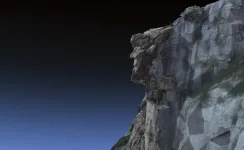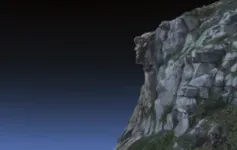(Press-News.org) Twenty years after the Old Man of the Mountain collapsed, audiences around the world will now be able to explore the iconic symbol of New Hampshire through an online interactive 3D model created by Matthew Maclay, a graduate student in earth sciences at Dartmouth's Guarini School of Graduate and Advanced Studies.
The face-shaped granite formation on the northeast side of Cannon Cliff in Franconia Notch State Park fell off the cliff on May 3, 2003, drawing international attention and dismay in New Hampshire itself.
"People continue to have a very emotional connection to the Old Man of the Mountain—the state emblem of New Hampshire, so I am really excited that this 3D model will provide the public with an opportunity to learn more about this natural wonder and the weathering processes affecting the underlying geological structure of the area," says Maclay.
As part of the research project, Maclay and collaborators Jesse Casana and Carolin Ferwerda at Dartmouth’s Spatial Archaeometry Lab performed aerial surveys of Cannon Cliff using a drone. They then reconstructed the now lost profile using original film negatives taken between 1958 and 1976 that documented the Old Man of the Mountain and surrounding area during maintenance conducted by the profile’s caretakers.
Maclay processed the imagery in the Planetary Surface Processes Computing Lab led by Marisa Palucis, an assistant professor of earth sciences at Dartmouth. By applying photogrammetry, a technique akin to the way that eyes provide depth perception, Maclay was able to create a 3D model of Cannon Cliff with and without the Old Man of the Mountain.
"As a New Hampshire native, I visited the Old Man many times as a child and like so many other state residents I felt a real sense of loss when it finally collapsed," says collaborator Jesse Casana, a professor of anthropology and director of the Spatial Archaeometry Lab at Dartmouth. "I’m really happy to be part of this project helping to digitally bring the Old Man back to life."
Through the modern 3D model, viewers can zoom around Cannon Cliff, which is approximately one mile across and 1,000 feet tall in size and see where the Old Man used to be located.
"Cannon Cliff is one of the largest cliffs in the eastern United States and it looms over a massive pile of rocky debris ranging in size from sand to boulders larger than cars," says Maclay. "It's an enormous slope of loose rocks, which serves as evidence of the efficient bedrock weathering and rockfall that has been taking place since the last ice sheet retreated, around 12,000 years ago."
In his research, Maclay is studying how climate-based processes break down bedrock physically and chemically in place, which in turn loosens and frees up the bedrock for rockfall.
"Understanding which areas of Cannon Cliff may be especially susceptible to rockfall is important given the popularity of the area as a year-round climbing and tourist destination," he says.
"The bedrock weathering processes are also significant because they are breaking down rocks on the slope into sediment, which is how soil is made," says Maclay.
Prior research has found that the cold, harsh winters and warm, wet summers in the White Mountains create conditions for efficient soil production, which may be affected by a warming climate.
As part of the ongoing project, the researchers installed 24 sensors that record the bedrock temperature at Cannon Cliff. They will also be conducting laboratory analyses of rock samples from the area to investigate chemical changes in minerals due to mildy acidic rainwater and snowmelt.
Through the model, Maclay was able to estimate the volume and mass of rock that was lost when the Old Man of the Mountain fell, which couldn’t be calculated until now. According to his measurements, around 750 cubic meters of granite fell, so he says it would have been tremendously heavy.
"The Old Man of the Mountain may have weighed nearly 2,000 tons, when it collapsed," says Maclay. "While 3-inch turn buckles had been bolted into the Old Man to try and prevent it from falling, the actual strength of the granite was degraded over centuries and that's probably why it collapsed."
He says the same forces that shaped the Old Man of the Mountain are still active on Cannon Cliff today.
"The Old Man's face is no longer perched on that rocky outcrop, but he wasn't the first rockfall and he's not the last. There are still rockfalls happening at Cannon Cliff, as it's one of the most dynamic places in the White Mountains."
The debut of the 3D model coincides with a virtual event on Wednesday, May 3 at 11 a.m. commemorating the 20th anniversary of the collapse.
Sponsored by the Old Man of the Mountain Legacy Fund, the online event will feature a historical perspective from the Museum of the White Mountains in Plymouth, N.H., on how the Old Man shaped New Hampshire's identity from its first recorded discovery in the early 19th century until today.
It will also include an introduction to the ongoing geological research of the Old Man and the Cannon Cliff by Maclay and a medley of personal stories and poems from local public school students in Franconia, N.H. and Lincoln, N.H.
The event will also feature the release of a new song, Great Stone Face, by New Hampshire songwriter Rick Lang. For more information about the virtual event and other anniversary-related events, visit: oldmannh.org. (Registration is required for the online event on May 3).
"This model has for the first time enabled a precise determination of how much rock fell from Cannon Cliff when the Old Man collapsed," says Brian K. Fowler, president of the Old Man of the Mountain Legacy Fund, a longtime scholar of the White Mountains and engineering geologist, who conducted the geological survey in 1976 prior to the construction of Interstate 93 through Franconia Notch.
"For years, Brian Fowler has studied Cannon Cliff to understand the geology and stability of the Old Man of the Mountain, and well before that, there were efforts to preserve the delicate formation," says Maclay. "One of the most rewarding aspects of this project has been collaborating with Brian and meeting so many people who care about the cliff."
In addition to the Old Man of the Mountain Legacy Fund, the project has also been coordinating with the New Hampshire Departments of Environmental Services and of Natural and Cultural Resources, New Hampshire State Parks, New Hampshire Geological Survey, and Mount Washington Observatory.
“I hope that our research will get people excited about visiting Franconia Notch State Park, where they can look at the stunning Cannon Cliff from some of the many nearby hiking trails and see 'geology in action,' as we like to call it,” says Maclay.
Maclay is available for comment at: matthew.t.maclay.gr@dartmouth.edu.
###
END
Interactive 3D model recreates Old Man of the Mountain
Dartmouth graduate student details iconic rockface which collapsed 20 years ago.
2023-05-01
ELSE PRESS RELEASES FROM THIS DATE:
Thrift shops thrive when disorder is balanced with high seller knowledge
2023-05-01
UNIVERSITY PARK, Pa. — One person’s trash may well be another’s “come up,” or what the rapper Macklemore calls hidden treasures in the song “Thrift Shop,” but only if secondhand shoppers follow the rapper’s lead and dig through what are sometimes messy bins. New research from Penn State and Texas Christian University shows that shoppers looking to “pop some tags” may be drawn to disordered thrift shop displays because they signal hidden treasure in their inventory.
“Secondhand markets are growing in ...
Exposure to airplane noise increases risk of sleeping fewer than 7 hours per night
2023-05-01
A new study has found that people who were exposed to even moderate levels of aircraft noise were less likely to receive the minimum recommended amount of sleep each night, and this risk increased among people living in the Western U.S., near a major cargo airport, or near a large water body, and among people with no hearing loss.
As major airline officials predict another record summer air travel season, a new analysis by Boston University School of Public Health (BUSPH) and Oregon State University has found that exposure to even moderate levels of airplane noise may disrupt sleep, building upon a growing body of research ...
X-ray imaging captures fleeting defects in sodium-ion batteries
2023-05-01
ITHACA, N.Y. - Sodium-ion batteries have been touted as a sustainable alternative to lithium-ion batteries because they are powered by a more abundant natural resource. However, sodium-ion batteries have hit a significant snag: the cathodes degrade quickly with recharging.
A Cornell University-led collaboration succeeded in identifying an elusive mechanism that can trigger this degradation – transient crystal defects – by using a unique form of X-ray imaging that enabled the researchers to capture the fleeting defects while the battery was in operation.
The group’s ...
AGS welcomes 16 new fellows recognized for exceptional commitment to geriatrics
2023-05-01
New York (May 1, 2023) — Today the American Geriatrics Society (AGS) announced the 16 AGS members who have been awarded AGS Fellowship. This distinction recognizes AGS members for their deep commitment to the AGS and to advancing high-quality, person-centered care for us all as we age. The new AGS fellows will be formally recognized at the 2023 AGS Annual Scientific Meeting (#AGS23; May 4-6).
“We are delighted to be recognizing our AGS member colleagues for their ...
In US system of allocating livers for transplanting, geographic inequity persists despite recent policy changes
2023-05-01
In the United States, an average of three people die every day waiting for a liver transplant, which resulted in nearly 1,200 lives lost in 2021. Liver allocation policy has undergone major modifications in the last 10 years. In a new study, researchers examined these policies, finding that despite the changes, geographic inequity persists. The authors recommend a more efficient and equitable way to allocate livers.
The study, by researchers at Carnegie Mellon University (CMU) and the University of Maryland (UMD), is forthcoming in Manufacturing & Service Operations Management.
“We suggest policymakers move away from the ‘one- size-fits-all’ approach of current ...
Prolonged power outages, often caused by weather events, hit some parts of the U.S. harder than others
2023-05-01
Joan Casey lived through frequent wildfire-season power outages when she lived in northern California. While waiting for the power to return, she wondered how the multi-day blackouts affected a community’s health.
“For me it was an inconvenience, but for some people it could be life-threatening,” said Casey, now an assistant professor in the University of Washington’s Department of Environmental and Occupational Health Sciences. “If you had an uncle that ...
Columbia University study finds that improved access to mental health care is associated with reductions in suicide risk
2023-05-01
Amid historically high suicide rates and mental health care provider shortages, new research from Incite @ Columbia University suggests that interventions to alleviate mental health care access disparities can prevent unnecessary death and suffering. In an article pending publication in PNAS next week, “Differential Spatial-Social Accessiblity to Mental Health Care and Suicide," Daniel Tadmon and Peter S. Bearman find that in the United States improved access to mental health care is associated with reductions in suicide risk.
To enable this research, Tadmon and Bearman developed new methods of measuring access ...
Chances of eliminating HIV infection increased by novel dual gene-editing approach
2023-05-01
EMBARGO UNTIL: May 1, 2023 at 3 PM ET
Gene-editing therapy aimed at two targets – HIV-1, the virus that causes AIDS, and CCR5, the co-receptor that helps the virus get into cells – can effectively eliminate HIV infection, new research from the Lewis Katz School of Medicine at Temple University and the University of Nebraska Medical Center (UNMC) shows. The study, published online in the journal The Proceedings of the National Academy of Sciences (PNAS), is the first to combine a dual gene-editing strategy with antiretroviral ...
Scientists discover anatomical changes in the brains of the newly sighted
2023-05-01
CAMBRIDGE, MA — For many decades, neuroscientists believed there was a “critical period” in which the brain could learn to make sense of visual input, and that this window closed around the age of 6 or 7.
Recent work from MIT Professor Pawan Sinha has shown that the picture is more nuanced than that. In many studies of children in India who had surgery to remove congenital cataracts beyond the age of 7, he has found that older children can learn visual tasks such as recognizing ...
NYU Abu Dhabi study identifies brain structures that underlie sight recovery in blind teenagers
2023-05-01
Fast facts:
Congenital cataracts are the leading cause of treatable blindness in children worldwide. In nations where the surgery is widely available, surgery occurs during infancy and there is a good prognosis for the recovery of visual function.
It is widely accepted that the window for surgical intervention for congenital cataracts closes by the time a child reaches the ages of six to eight years old, as that is a critical period for visual brain development. Restoration of the visual input later in life is generally ...
LAST 30 PRESS RELEASES:
Interaction of climate change and human activity and its impact on plant diversity in Qinghai-Tibet plateau
From addressing uncertainty to national strategy: an interpretation of Professor Lim Siong Guan’s views
Clinical trials on AI language model use in digestive healthcare
Scientists improve robotic visual–inertial trajectory localization accuracy using cross-modal interaction and selection techniques
Correlation between cancer cachexia and immune-related adverse events in HCC
Human adipose tissue: a new source for functional organoids
Metro lines double as freight highways during off-peak hours, Beijing study shows
Biomedical functions and applications of nanomaterials in tumor diagnosis and treatment: perspectives from ophthalmic oncology
3D imaging unveils how passivation improves perovskite solar cell performance
Enriching framework Al sites in 8-membered rings of Cu-SSZ-39 zeolite to enhance low-temperature ammonia selective catalytic reduction performance
AI-powered RNA drug development: a new frontier in therapeutics
Decoupling the HOR enhancement on PtRu: Dynamically matching interfacial water to reaction coordinates
Sulfur isn’t poisonous when it synergistically acts with phosphine in olefins hydroformylation
URI researchers uncover molecular mechanisms behind speciation in corals
Chitin based carbon aerogel offers a cleaner way to store thermal energy
Tracing hidden sources of nitrate pollution in rapidly changing rural urban landscapes
Viruses on plastic pollution may quietly accelerate the spread of antibiotic resistance
Three UH Rainbow Babies & Children’s faculty elected to prestigious American Pediatric Society
Tunnel resilience models unveiled to aid post-earthquake recovery
Satellite communication systems: the future of 5G/6G connectivity
Space computing power networks: a new frontier for satellite technologies
Experiments advance potential of protein that makes hydrogen sulfide as a therapeutic target for Alzheimer’s disease
Examining private equity’s role in fertility care
Current Molecular Pharmacology achieves a landmark: real-time CiteScore advances to 7.2
Skeletal muscle epigenetic clocks developed using postmortem tissue from an Asian population
Estimating unemployment rates with social media data
Climate policies can backfire by eroding “green” values, study finds
Too much screen time too soon? A*STAR study links infant screen exposure to brain changes and teen anxiety
Global psychiatry mourns Professor Dan Stein, visionary who transformed mental health science across Africa and beyond
KIST develops eco-friendly palladium recovery technology to safeguard resource security
[Press-News.org] Interactive 3D model recreates Old Man of the MountainDartmouth graduate student details iconic rockface which collapsed 20 years ago.





